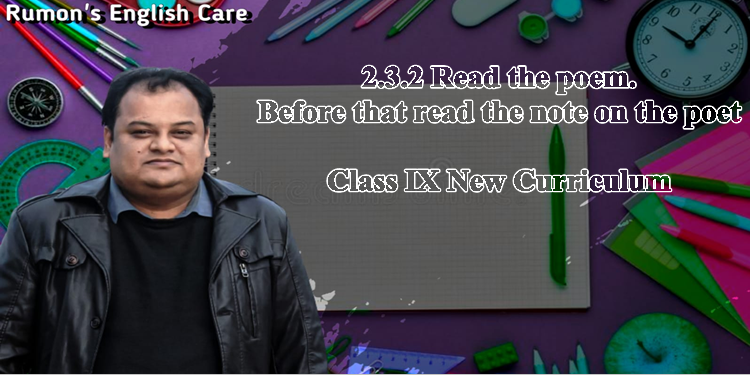2.3.2 Read the poem. Before that read the note on the poet
2.3.2 Read the poem. Before that read the note on the poet. কবিতাটি পড়ো। পড়ার পূর্বে কবি সম্পর্কে note-টি পড়ো।
Note:
Alfred Lord Tennyson (1809-1892) was a renowned British poet. He became famous for writing about love, nature and emotions. Now, let’s read one of his famous poems on nature ‘Crossing the Bar’.
Crossing the Bar
BY ALFRED, LORD TENNYSON
Sunset and evening star,
সূর্যাস্ত এবং সন্ধ্যার তারা,
And one clear call for me!
যা আমার জন্য একটি স্পষ্ট ডাক!
And may there be no moaning of the bar,
আর সেখানে কোনো প্রতিবন্ধকতার আহাজারি না থাকুক
When I put out to sea,
আমার সমুদ্রে যাওয়ার সময়,
But such a tide as moving seems asleep,
তবে প্রবাহমান জোয়ার যেন ঘুমন্ত এমন মনে হয়,
Too full for sound and foam,
যা শব্দ ও ফেনায় অত্যধিক পূর্ণ
When that which drew from out the boundless deep
যা সীমাহীন গবির থেকে সৃষ্ট
Turns again home.
আবার তা স্বস্থানে ফিরে যায়।
Twilight and evening bell,
গোধূলি এবং সন্ধ্যার ঘন্টা,
And after that the dark!
আর তার পরেই আসে অন্ধকার নেমে!
And may there be no sadness of farewell,
আর বিদায়ে কোনো দুঃখ না থাকুক,
When I embark;
আমার যাত্রার সময়;
For tho’ from out our bourne of Time and Place
কারণ যদিও সময় ও স্থানের সীমা থেকে
The flood may bear me far,
প্লাবন আমাকে অনেক ধূরে বয়ে নিয়ে যেতে পারে,
I hope to see my Pilot face to face
তবুও আমার পাইলটকে সামনাসামনি দেখার আশা করি
When I have crost the bar.
আমার প্রতিবন্ধক অতিক্রম করার সময়।
2.3.2 Now, read the following summary of the poem for your better understanding and answer the following questions.
In the poem, the poet talks about death and the journey into the afterlife. Here, he uses symbols from nature like sunset, evening star, sea, tide, foam, twilight, evening bell, and flood to explain his feelings and ideas.
Besides, if you read carefully, you can understand that like others, the poet also expresses his desire to cross the bar between life and death without sorrowful farewells.
The poem accepts the truth that we have to leave this world, and he wishes to be calm and peaceful in the face of morality.
Question:
(a)What is the poem about?
(b) Have you found any symbols in the poem? If yes, what are those?
(c) Do you think symbol helps the poet express his ideas in a better way? If yes, explain with an example.
Answers:
(a) The poem reflects on the theme of death and the transition from life to the afterlife. Tennyson wrote this poem in the last days of his life, and it is often interpreted as a reflection on his own morality. It is noted that from the first line to the last of the poem.
(b) “Crossing the Bar” by Alfred Lord Tennyson is rich in symbolic imagery. Here are some Key symbols in the poem:
The Bar: The central symbol in the poem is the “bar” which represents the boundary between life and death.
The Sea: The act of ‘putting out to sea’ can be interpreted as a metaphor for the journey into the afterlife, symbolizing the crossing from the realm of the living to realm of the dead.
The Setting Sun: The setting sun in the poem represents the end of the life.
Twilight and Evening Bell: These elements symbolize the closing of a day or life.
Pilot: The “Pilot” mentioned in the poem can be seen as a symbol representing a spiritual guide who guide the poet’s ship as it crosses the bar during the journey from life to death.
(c) Sunset and evening star: “Sunset” and “Evening star” represent the end of the day. Just as the day is about to end, the speaker says that his life is drawing the journey from life to death.
Clear Call: The word ‘clear call” represents that someone is calling the speaker. It is a clear, unmistakable call. It is call of death. The speaker believes that he is approaching towards death.
(d) Yes, I think symbols are powerful tools in literature that help express complex ideas, themes, and emotions more effectively. For example, a heart can symbolize love, a dive peace, or a clock the passage of time, Symbols have the ability to evoke emotions and create vivid mental images. They can also trigger an emotional response and enhance the overall impact of the writing.
Additional Things Need To Learn
- Satire
Satire refers to a play, novel, poem, film or other composition which uses comedy, irony, mockery, and exaggeration to criticize the absurdity or weaknesses of a certain person, institution, or situation. Often, satire utilizes comedy for more serious means, such as political and social commentary.
- Hyperbole
Hyperbole is a remarkably exaggerated statement or idea meant to be taken figuratively rather than literally. Hyperbole exaggerates certain elements of ideas or things for comedic or dramatic effects. Here are a few examples of hyperbole:
- I’m so hungry I could eat a horse!
- That was the best performance I’ve ever seen in my entire life.
- I’d kill for a glass of Coca-Cola.
- Imagery:
A term used to describe an author’s use of vivid descriptions “that evoke sense-impressions by literal or figurative reference to perceptible or ‘concrete’ objects, scenes, actions, or states” (Baldick 121). Imagery can refer to the literal landscape or characters described in a narrative or the theoretical concepts an author employs.
- Theme:
According to Baldick, a theme may be defined as “a salient abstract idea that emerges from a literary work’s treatment of its subject-matter; or a topic recurring in a number or literary works” (Baldick 258). Themes in literature tend to differ depending on author, time period, genre, style, purpose, etc.
- Irony:
Typically refers to saying one thing and meaning the opposite, often to shock audiences and emphasize the importance of the truth.

